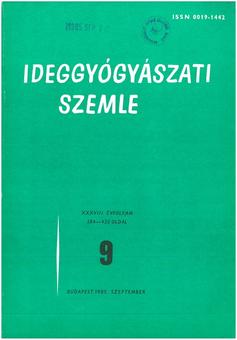The eLitMed.hu medical portal uses computer cookies for convenient operation. Detailed information can be found in the Cookie-policy.
Clinical Neuroscience - 1985;38(09)
Content
[Vascular morphology of small (miliary) ischaemic foci in the human cerebral cortex*]
[Based on a comparison of the morphological features of the cerebral vasculature, the authors believe that the most common small cortical ischaemic clots in their patients with bilateral internal carotid artery occlusion at different ages were due to spatial and temporal asymmetry of blood flow caused by disturbances in local circulatory control, rather than to embolic, inflammatory or other origins of the cortical arteries, as previously reported in similar cases. It has also been suggested that a significant reduction in the diameter of the capillaries within the arteries may play a role in the development of such foci.]
[Preoperative and postoperative outcomes in patients with multiple sclerosis undergoing porcine brain transplantation]
[The author reports the results of neurological examination of 5 patients with clinically definite MS before and after pig brain implantation and presents histological findings of some types of fresh foci of MS in 2 patients who died during postoperative exacerbation. No objective improvement in the neurological status of either patient was observed after this intervention. In hindsight, it highlights the danger of surgery. The analysis of the course of his patients' disease supports a consistent autoimmune pathogenesis of leukoencephalitis.]
[The role of parental attitudes in the socialisation of families at risk]
[Indeed, the groups according to the degree of vulnerability show significant differences in the warmth of the parent's parenting attitudes and the openness of communication within the family. We consider our results to be a partially valid starting point for answering questions of practical family therapy. These can be summarized on three levels: a) understanding the social background and social situation of the family (Cseh-Szombathy, [4]); b) exploring the developmental cycles of family life (Weeks, Wright, [17]), specific family traditions and myths (Byng-Hall, [3]); c) highlighting current dysfunctional behavior patterns (Weakland, Fisch, Watzlawick and Bodin, [15]). While the outlines of family therapy work the relevant theoretical work can be obtained from abroad, while the practical, therapeutic work cannot be carried out without knowledge of the domestic conditions can be carried out effectively.]
[Myasthenia gravis: Preventing drug-induced cholinergic symptoms with dexetimidum]
[The author uses dexetimidum (Tremblex, KGy), which has a strong anticholinergic effect, to prevent and reduce cholinergic symptoms that are unpleasant and even dangerous to breathe, in the treatment of myasthenic patients. Over a three-year period, 56 patients were observed to have an effect of the drug on side effects only. Routine use mainly in crisis or praecrisis, and in cases with cholinergic side effects.]
Penetration of anticonvulsant drugs into the cerebrospinal fluid in epileptic patients
ln 32 adult patients with epilepsy DPH and phenobarbital levels were determined in serum and CSF. ln 10 patients B-0-B permeability was evaluated by measurement of bilirubin in CSF. Major individual differences in DPH and phenobarbital levels in serum and CSF have been noticed. Percentage of DPH penetration into CSF ranged from 1-59%, and phenobarbital from 40-69%. ln cases with increased permeability of blood-CSF barrier drugs penetration into CSF was higher.
[Co-occurrence of cerebellar aneurysm and trigeminal artery primitiva]
[The authors report an artery aneurysm associated with arteria communicans anterior trigemina primitiva are described. They review the literature and discuss the clinical significance of PrTA.]
1.
Clinical Neuroscience
[Headache registry in Szeged: Experiences regarding to migraine patients]2.
Clinical Neuroscience
[The new target population of stroke awareness campaign: Kindergarten students ]3.
Clinical Neuroscience
Is there any difference in mortality rates of atrial fibrillation detected before or after ischemic stroke?4.
Clinical Neuroscience
Factors influencing the level of stigma in Parkinson’s disease in western Turkey5.
Clinical Neuroscience
[The effects of demographic and clinical factors on the severity of poststroke aphasia]1.
2.
Clinical Oncology
[Pancreatic cancer: ESMO Clinical Practice Guideline for diagnosis, treatment and follow-up]3.
Clinical Oncology
[Pharmacovigilance landscape – Lessons from the past and opportunities for future]4.
5.



